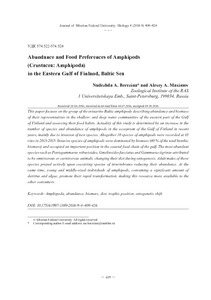Показать сокращенную информацию
Количественные характеристики и пищевые предпочтения бокоплавов (Crustacea: Amphipoda) в восточной части Финского залива Балтийского моря
| Автор | Березина, Н.А. | ru_RU |
| Автор | Максимов, А.А. | ru_RU |
| Автор | Berezina, Nadezhda A. | en |
| Автор | Maximov, Alexey A. | en |
| Дата внесения | 2016-12-27T04:13:59Z | |
| Дата, когда ресурс стал доступен | 2016-12-27T04:13:59Z | |
| Дата публикации | 2016-12 | |
| URI (для ссылок/цитирований) | https://elib.sfu-kras.ru/handle/2311/30325 | |
| Аннотация | В данной статье рассмотрены амфиподы из группы эстуарных балтийских видов, в том числе их представленность в прибрежных и глубоководных сообществах восточной части Финского залива, и оценено их значение в трофических цепях. Актуальность работы определена слабой изученностью этой группы и вместе с тем значительным увеличением числа видов и их обилия в экосистеме Финского залива в последние годы в основном за счет вселения новых видов. В период изучения (2013-2015 гг.) на 43 станциях всего зарегистрировано 10 видов. Инвазионные амфиподы разных видов, недавно вселившиеся в залив, доминировали по биомассе (около 40 % всей биомассы зообентоса) и заняли важную позицию в прибрежных пищевых цепях. Массовые виды, Pontogammarus robustoides, Gmelinoides fasciatus и Gammarus tigrinus, отнесены к всеядным или хищным животным, меняющим свой способ и объекты питания в процессе онтогенеза. Взрослые особи этих видов – активные хищники, способные снижать численность сосуществующих с ними видов беспозвоночных. В то же время их молодь и особи среднего размера, потребляя в значительном количестве детрит и водоросли, способствуют их переработке, делая этот ресурс доступным для других консументов | ru_RU |
| Аннотация | This paper focuses on the group of the estuarine Baltic amphipods describing abundance and biomass of their representatives in the shallow- and deep water communities of the eastern part of the Gulf of Finland and assessing their food habits. Actuality of this study is determined by an increase in the number of species and abundance of amphipods in the ecosystem of the Gulf of Finland in recent years, mainly due to invasion of new species. Altogether 10 species of amphipods were recorded at 43 sites in 2013-2015. Invasive species of amphipods were dominated by biomass (40 % of the total benthic biomass) and occupied an important position in the coastal food chain of the gulf. The most abundant species such as Pontogammarus robustoides, Gmelinoides fasciatus and Gammarus tigrinus attributed to be omnivorous or carnivorous animals, changing their diet during ontogenesis. Adult males of these species preyed actively upon coexisting species of invertebrates reducing their abundance. At the same time, young and middle-sized individuals of amphipods, consuming a significant amount of detritus and algae, promote their rapid transformation, making this resource more available to the other consumers | en |
| Язык | ru | ru_RU |
| Издатель | Сибирский федеральный университет. Siberian Federal University | en |
| Тема | Amphipoda | ru_RU |
| Тема | численность | ru_RU |
| Тема | биомасса | ru_RU |
| Тема | питание | ru_RU |
| Тема | трофические уровни | ru_RU |
| Тема | онтогенетическая дифференциация | ru_RU |
| Тема | Amphipoda | en |
| Тема | abundance | en |
| Тема | biomass | en |
| Тема | diet | en |
| Тема | trophic position | en |
| Тема | ontogenetic shift | en |
| Название | Количественные характеристики и пищевые предпочтения бокоплавов (Crustacea: Amphipoda) в восточной части Финского залива Балтийского моря | ru_RU |
| Альтернативное название | Abundance and Food Preferences of Amphipods (Crustacea: Amphipoda) in the Eastern Gulf of Finland, Baltic Sea | en |
| Тип | Journal Article | |
| Тип | Published Journal Article | |
| Контакты автора | Березина, Н.А.: Зоологический институт РАН Россия, 199034, Санкт-Петербург, Университетская наб., 1 | ru_RU |
| Контакты автора | Максимов, А.А.: Зоологический институт РАН Россия, 199034, Санкт-Петербург, Университетская наб., 1 | ru_RU |
| Контакты автора | Berezina, Nadezhda A.: Zoological Institute of the RAS 1 Universitetskaya Emb., Saint-Petersburg, 199034, Russia; na-berezina@rambler.ru | en |
| Контакты автора | Maximov, Alexey A.: Zoological Institute of the RAS 1 Universitetskaya Emb., Saint-Petersburg, 199034, Russia | en |
| Страницы | 409-426 | |
| Журнал | Журнал Сибирского федерального университета. Биология. Journal of Siberian Federal University. Biology;2016 9 (4) | en |

